The God who sees me: Worship resources for Sanctuary Sunday
A downloadable version of this resource is available for anyone who would like to save or print it out.
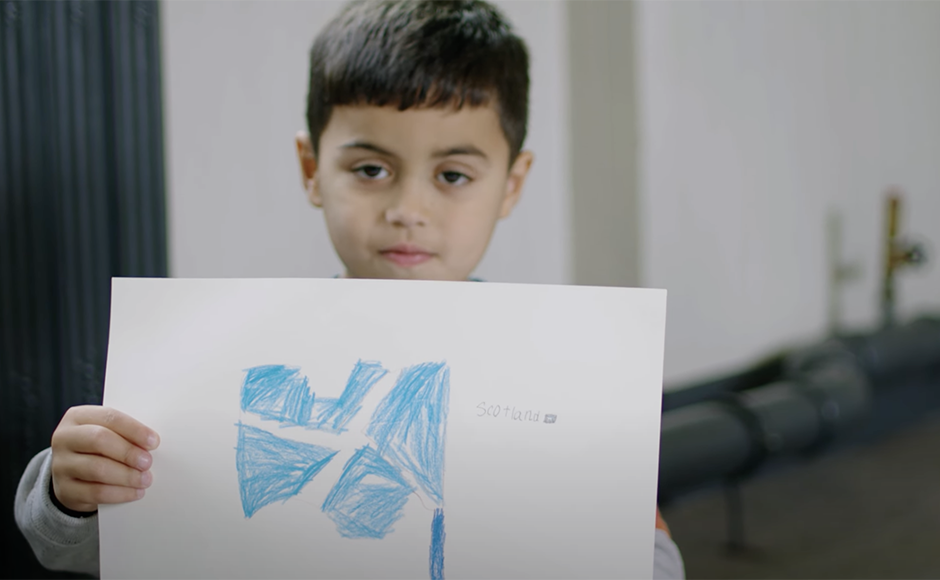
Inspiration and resources for worship on Sanctuary Sunday.
Introduction
Churches across the UK and the world are encouraged to celebrate Sanctuary Sunday (also called Refugee Sunday) on the Sunday following World Refugee Day on 20 June.
There are more displaced people in the world today than at any other point in history and the Bible is clear in its expression of God's loving concern for the stranger and refugee. Sanctuary Sunday is an opportunity to be reminded of the need to welcome the stranger, the alien and the sojourner and to see in all people our common humanity, that we are all created in the image of God, and we are all deserving of dignity and worth.
We have produced this resource to help you mark the day in your own churches and communities. In it, you will find a variety of contributions that can help you shape different elements of your service, including the sermon, children's talk, prayers and mid-week Bible studies. Please use it as a menu to pick and choose from and adapt it to your own context.
The theme for this year's Sanctuary Sunday is "El Roi" – "the God who sees me". In Genesis (16; 21:8-21) we read the story of Hagar, Sarah's slave. Hagar is a foreigner from Egypt, mistreated by Sarah and Abraham, fleeing into the wilderness, returning only to be driven away again by her masters. Her time in the wilderness is marked by despair, sorrow and fear of death. But there is one who sees her; one who provides safety, protection and care – sanctuary, in the hardest of places. In response, Hagar calls God "El Roi" – "the God who sees me". This is a God who knows her pain deeply and doesn't leave her alone in it.
Hagar's story will be familiar to many people fleeing their homes and seeking sanctuary in Scotland today. Disowned, dehumanised, forced away, scared, searching and hoping. Our biggest wish for people arriving on our shores is that they too can say: ‘God sees me, knows my pain, is providing for my needs, and is offering me a place of sanctuary'.
As we mark Sanctuary Sunday, we want to consider the scriptures and ask how we can be the hands and feet of God and offer sanctuary to refugees and asylum seekers in our midst. How can we embrace the joys and talents that sit alongside their pain and loneliness? Sanctuary Sunday is a special Sunday set aside to pray for the stranger in our midst and say to the refugee and asylum seeker: 'we see you, and there is a God who sees you too'.
Visit our Scottish Faiths Action for Refugees website for more resources you can use to include in and shape your Sanctuary Sunday services. "God with us" is a Christian worship resource on the theme of refugees, migration and sanctuary. You can download your copy or request free printed copies.
- Sabine Chalmers
Contents
- Journeys in Scripture: Hagar and the God who sees
- Journeys of Faith and Welcome: Videos and Bible study
- Journeys together: Children's and all-age resources
- Journeys retold: Stories of refuge and seeking asylum
- Journeys through lament and hope: Creative prayer resources
Journeys in Scripture: Hagar and the God who sees
The reflections provided in this section are based on the story of Hagar, which can be found in Genesis 16 and 21:8-21. Tatiana from Ukraine provides a reflection on the passage from the perspective of her lived experience of seeking refuge, followed by sermon notes by David Moodie from Scottish Faiths Action for Refugees. More resources based on the Common Lectionary passages for Sanctuary Sunday can be found in the Church of Scotland's Weekly Worship resources.
The God who sees me – a reflection on Genesis 21:8-21
My name is Tatiana and I am from Odessa, Ukraine. I moved to Edinburgh in May 2022 due to the war in my country. My son and daughter-in-law remained in Ukraine, as well as some of my friends. In Edinburgh, God gave me a wonderful family that took me in, as well as a wonderful church called Bellevue Chapel! I am very grateful to the Lord for His support and hope!
Imagine a desert. Wherever you look, all you can see is sand everywhere. There are no trees or any other vegetation, except for dry bushes. The sun burns everything that tries to grow, and you have a long road ahead through this parched land. There is nothing suitable to shelter you from the heat, there is not a single source of water along the road, only what you have taken with you. You are alone; it's just you and the boy – the son you are responsible for. There is not a single other person around who could help you if necessary. And you wander in a direction unknown to you, no destination, not knowing where to turn, just wandering, hoping for safety. The situation is dire. What could be worse than this?
Many Ukrainians have found themselves in this situation during the war. You're running from danger, but you don't know where to. In your hand is one suitcase, which now holds all your life's belongings. And sometimes you don't even have a suitcase – I did not have time to collect mine. In your hands are the hands of your children. Who will help? Where to run to? Where can you expect help? Everything around is new and unfamiliar. There are people around, but it is as if you are in a desert. Only you and your problems and no-one who could help!
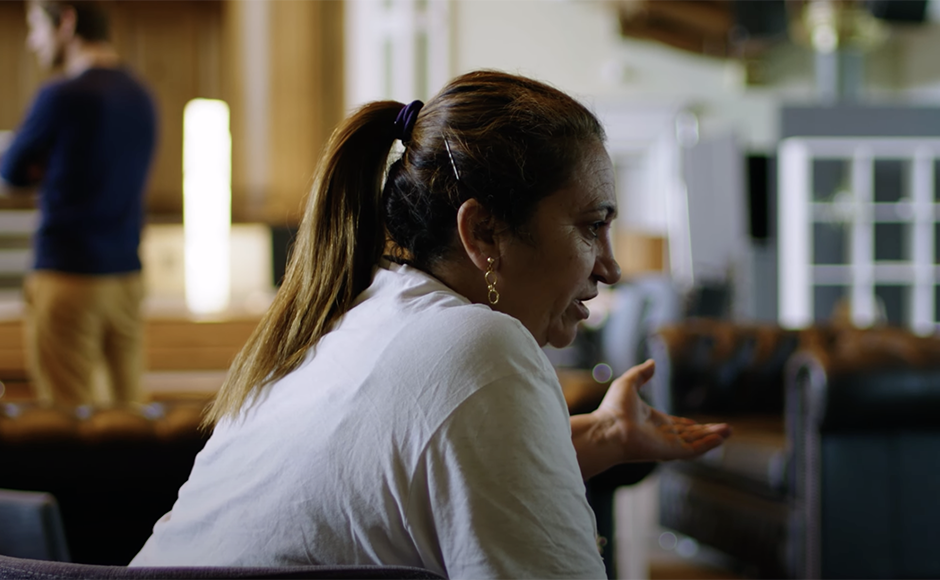
In Genesis 21 we meet Hagar, the servant of Sarah, in a very similar situation. Hagar and her son Ishmael are displaced in the wilderness after being sent away by her masters. The sun is burning down, and the parched land that leads to nowhere exhausts the travellers. Eventually the provisions are empty, the last drop of water gone. What could be worse? Without water in the desert the chances of survival are zero. Hagar understands very well that her own strength is not enough to save her son and herself, and there is no need to count on help from others as there is not a soul around. What can a single woman do in such a situation?
Hagar makes the only decision she feels she can make in this situation. She leaves her son and goes a bowshot away so as not to see, and perhaps not hear, how he will die, and she begins to cry. No one will hear her, but perhaps Hagar's cries will silence her son's cries. Incredibly though, there was one who sees and hears the voice of the boy. The angel of God calls to Hagar and says: ‘Do not be afraid; God has heard the boy crying as he lies there. Lift the boy up and take him by the hand, for I will make him into a great nation.' (vv17-18). And God opened her eyes, and she saw a well of water. God sees their distress and restores both her and Ishmael's physical wellbeing as well as their dignity, safety and protection through the promise of a family.
This was Hagar's second meeting with God. The first happened when Hagar had to flee from her mistress into the wilderness after being mistreated (Genesis 16). The angel of the Lord seeks her out in love and care for her. Hagar has a very personal encounter with God and gives God the name "El Roi", saying: ‘You are the God who sees me!'
God met Hagar twice in a desperate situation of displacement. God truly sees and understands her, and her worries and pain. God saves and restores her and promises a hopeful future. This is the God who sees you too.
This is my God, the God in whom I believe! The God who knows all my difficulties and experiences, who does not leave me alone, but empathises and helps me! This is the God who gives hope, and gives life! In the most difficult moments of my life, my Lord supported me and gave me hope! At the beginning of the war, I came across one expression that encouraged me: When I die, I will be with the Lord! If I live, the Lord will be with me. Live or die, I belong to the Lord!
Call the Lord into your life! And then you can say, ‘You are the God who sees me! You are the God who saves me!'
- Tatiana Bondarenko
Preaching Genesis 21:8-21 on Sanctuary Sunday
This passage is a powerful one to read on Sanctuary Sunday. As a woman who was forced to leave her home multiple times, her story reflects the experience of many refugees and asylum seekers. As you prepare your sermon or talk, consider these four questions:
- What leads to Hagar's displacement?
- What is Hagar's experience in the wilderness?
- What does she do in her hopelessness?
- How does God meet her in her need?
As Tatiana explained, Hagar was in a desparate situation. She had been failed by the people around her, treated cruelly and callously by people who we usually consider heroes of the faith. We see how Sarah acted out of selfishness and envy, even dehumanising Hagar, calling her ‘that slave woman'. This sadly bears similarities to the ways in which refugees are often failed by both individuals and institutions. More often than not, people seeking sanctuary are demonised, criminalised and marginalised rather than treated as equally worthy of dignity and respect.
In the wilderness, Hagar was alone without the safety network of a family or protection from wild animals or people who might want to harm or exploit her and her son. She was also without long-term provisions and had no means of providing for herself. She was wandering – she had nowhere to go, no home, no one who would accept a banished foreign woman and her child. As Tatiana highlights, these experiences of wilderness are so familiar to people forced from their homes across the globe. The "A Heart for Refugees" stories in the section below highlight this.
In her hopelessness, Hagar cries. She had been forgotten by everyone, but not by God. God came to her in her deepest need and responded to her cry, first with a listening ear, and then with life-sustaining water. This passage reveals to us a God of compassion and caring love. When the world had discarded Hagar, God did not.
This is a hopeful message for all of us, but especially for people who have been forced to leave their homes. God sees us and God is faithful. This is what gave the Psalmist the confidence to say, "My help comes from the LORD, the Maker of heaven and earth." (Psalm 121) It's what gives Tatiana the confidence to say, ‘You are the God who sees me! You are the God who saves me!'
Preaching on this passage should remind us of God's unfailing compassion, especially for those who are suffering and going through a time of wilderness. It should also challenge us to see and hear others. People are more than their immigration status; they are individuals with stories, creativity and gifts to share. Churches that have opened their doors to those seeking sanctuary can testify to the ways they enrich their community. We should learn to see refugees not as an "other", but as fellow sojourners living in hope and seeking a new and abundant life.
- David Moodie
Journeys of Faith and Welcome: Videos and Bible study
Journeys of Faith and Welcome are a series of videos produced by Scottish Faiths Action for Refugees and Faith in Community Scotland to celebrate the stories of refugees and people seeking asylum, as well as faith communities and the role faith has played in their journeys of seeking, finding and offering sanctuary. These videos can be used during Sunday Services, mid-week meetings, or as a basis for discussion groups or Bible studies. We also hope the videos will inspire people across Scotland to play their part in building welcoming and cohesive communities.
Central Church: Friendship Café
Central Church has been welcoming New Scots since Syrian and Kurdish families first started arriving in Edinburgh in 2015. Inspired by their Christian faith, they seek to become home and family for those rebuilding their lives in the city. Over many years they have built deep relationships and friendships with New Scots, sharing life together and helping them settle. Once a month they also host welcome meals or coffee mornings in their church to enjoy a time of fellowship with New Scots in larger groups.
Discussion questions
- How does Sawsan describe the difficulties they face after arriving and the support she received?
- What difference has the church made in her life?
- What role can community and social connections play in our lives? Why are they particularly important in the lives of refugees?
- What does the Bible tell us about our role in welcoming the stranger (e.g. Matthew 25:31-40; Leviticus 19:33-34; Hebrews 13:2)?
Philomena's Story
Philomena is from Central Africa, seeking asylum in Scotland and lives in Glasgow. She speaks powerfully about the struggles people seeking asylum face in Scotland, including the times spent in isolating contingency hotels and the immigration laws which prevent her from being allowed to work.
She also speaks about the difference her local church made in her day-to-day life: ‘I never expected that my black skin colour would be seen as offensive, disgusting and annoying. But when I discovered my local church, St Aloysius RC Church in Glasgow, some things changed. I was welcomed with open arms and made to feel at home, to have a sense of belonging irrespective of the colour of my skin. They gave me reasons to be happy, hopeful and strong, alongside providing the financial and emotional support I needed to pull through, keeping my faith alive. I am now studying to become a nurse/midwife and I truly appreciate my local church for its support, and for helping me believe my future will be greater.'
Discussion questions
- What was life like for Philomena in an asylum hotel? (This can be an opportunity to find out more about why people are placed in asylum hotels and the impact it is having on their lives.)
- What brought about change in her life?
- What kept Philomena going? What keeps you going in the struggles of life?
- From Philomena's quote above, what can we learn about how Church can offer sanctuary from experiences of racism? What does that look like?
- How do we encounter God in the support we receive from others?
Mossvale Community Church
Mossvale Community Church is a local church in Paisley, Renfrewshire that set up a project called "Sewing2Gether All Nations" for members of the refugee and asylum seeker community. The project primarily supports women who wish to practise English and build new friendships. Through creative workshops, New Scots learn to sew and upcycle damaged or unloved clothes. Since establishing the project, they have worked with people seeking asylum, Syrian refugees and Ukrainian families, and most recently set up the All Nations Café and drop-in for refugees and people seeking asylum, particularly responding to the opening of a hotel for Ukrainians in the vicinity.
Discussion questions
- In which diverse ways is Mossvale Community Church supporting refugees and people seeking asylum?
- What skills and experiences do you see in your own church that could be utilised to support people settled in your community?
- How does Psalm 24 encourage you in connecting with people from all parts of the world?
- How can we build multicultural churches that reflect the communities around us?
Saowsan's Story
Saowsan came to Scotland from Iraq with her children and lives in the South of Glasgow. As with many others, she found a warm and safe welcome in Castlemilk Community Church which really helped her and her family settle into their new life in Scotland.
Castlemilk Community Church supports newcomers to Scotland by helping to tackle social isolation and making connections in the wider community. They encourage cross-cultural understanding through discussion groups and trips to places of interest. They also run employability sessions and provide a safe place to share life experiences and make friends.
Discussion questions
- What surprises Saowsan about the church? Why do you think she is surprised?
- What worries do you have about connecting with New Scots and people of other faiths?
- What does Saowsan appreciate about Scotland and the support she received?
- How is God calling you to respond?
Journeys together: Children's and all-age resources
Children's resources
Talking to children about refugees and people seeking asylum can be difficult but it is important to do. Our media is filled with negative stories and harmful stereotypes, so it's essential we offer an alternative narrative by talking in ways that are compassionate and caring as well as empowering.
We have structured these into a lesson plan for a children's group/Sunday school, but the ideas could be adapted into a talk as well.
Part 1: What would you take?
Description
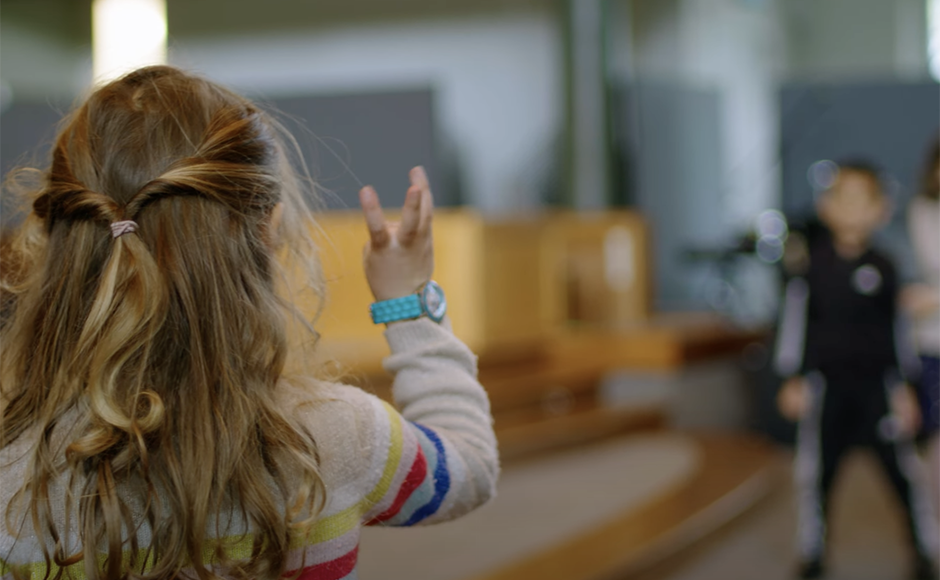
An exercise in which you ask children to think about what items they would take with them if they had to leave their home. This video may provide inspiration.
Learning intention
To understand and empathise with some of the difficult choices displaced people have to make.
Scripture
Do not eat it with bread made with yeast, but for seven days eat unleavened bread, the bread of affliction, because you left Egypt in haste—so that all the days of your life you may remember the time of your departure from Egypt. (Deuteronomy 16:3)
Prompt questions
What are some of your favourite things that you own? Imagine you had to leave your home and could only take a few objects. What would you bring with you?
Activity 1
- Bring a selection of objects and lay them out. Ask the children, ‘If you had to leave your house in a hurry, which of these would you bring?'
- Examples: food, toys, books, tech, photos, cooking utensils, a tent
- Introduce limits/constraints i.e. maximum number, weight, no access to electricity.
- Have the children write or draw what their personal list of objects to bring would be. (You could print off pictures of an empty suitcase and ask children to draw the items.)
- Talk to them about the decisions they made; which objects they chose and why they were prioritised.
Activity 2
- Have the children write or draw what their personal list of objects to bring would be. (You could print off pictures of an empty suitcase and ask children to draw the items.)
- Talk to them about the decisions they made; which objects they chose and why they were prioritised.
Lesson
This activity is based on many true stories. There are over 100 million people who have had to leave their homes like this. This could be due to war, to escape people trying to hurt them, or because there was a famine and they had no food to eat.
When they left they had to make hard choices about what to bring with them. Many aren't able to bring anything or lose items on their journeys. But one thing they don't lose is who they are, people with their own stories, faith, skills, experiences and joys. We are more than the things we own or possess. We have our identity in Christ and everyone is created in the image of God, no matter where they are from.
In the Bible, when God rescued his people from Egypt they had to leave in a hurry. They made unleavened bread (explain that unleavened bread is quicker) so they could leave quickly. During Passover, a festival to remember this period, the Israelites ate unleavened bread so they would never forget how God saved them.
Prayer
World Map Prayer: choose a country where people are displaced. Show the children where it is on the map and maybe some pictures of children from there.
Pray:
Loving God, we pray for ___. No refugee is a stranger to you. Watch over all children and families who have had to leave their homes. Help them find food, shelter, and safety.
Amen
Part 2: Warm welcome
Description
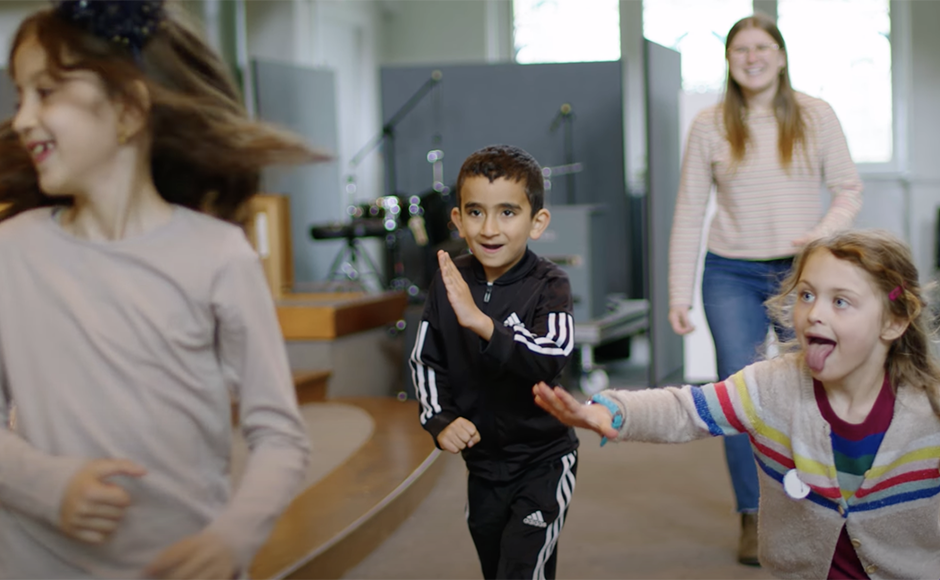
Exercises to help the children consider how they could welcome refugees.
Learning intention
To introduce the principles of integration through relatable experiences.
Scripture
Do not forget to show hospitality to strangers, for by so doing some people have shown hospitality to angels without knowing it. (Hebrews 13:2)
Prompt questions
- Can you remember a time when you went somewhere for the first time? (e.g. new school, club or church)
- How did it feel? (e.g. exciting, scary)
- What helped you feel safe/secure?
- Have one of the adults pretend to be a new person at their church/school. Don't introduce them as a New Scot (refugee or person seeking asylum), but incorporate some relevant aspects into the character (e.g. English as an additional language, difficulty trusting others)
- Ask the children how they would make them feel welcome, e.g. playing together, offering them a seat, asking them sensitive questions
- Act out a response to the suggestions made (become visibly happier and more comfortable)
- For older children, you could task them with preparing a short drama.
- Welcome hands bunting: have the children draw around their hands onto card and cut it out
- On each of the hands write an individual letter from the word WELCOME
- Use a holepunch to make holes to thread a string through so that the hands together spell out ‘welcome'
- As you make it, ask the young people about what makes a welcoming space. How can we make our church a friendly place for people who are new?
- Help them find places in the church to hang the bunting where visitors will see them. Say that they are reminders for us to practice the things we said would make the church a friendly place.
Activity 1
- Have one of the adults pretend to be a new person at their church/school. Don't introduce them as a New Scot (refugee or person seeking asylum), but incorporate some relevant aspects into the character (e.g. English as an additional language, difficulty trusting others)
- Ask the children how they would make them feel welcome, e.g. playing together, offering them a seat, asking them sensitive questions
- Act out a response to the suggestions made (become visibly happier and more comfortable)
- For older children, you could task them with preparing a short drama.
Activity 2: Welcome hands bunting
- Have the children draw around their hands onto card and cut it out
- On each of the hands write an individual letter from the word WELCOME
- Use a holepunch to make holes to thread a string through so that the hands together spell out ‘welcome'
- As you make it, ask the young people about what makes a welcoming space. How can we make our church a friendly place for people who are new?
- Help them find places in the church to hang the bunting where visitors will see them. Say that they are reminders for us to practice the things we said would make the church a friendly place.
Lesson
When refugees travel to a different country they have to get used to a lot of new things: a new home, new school, new jobs, new culture. This can be really hard. Some people struggle because they speak a different language. Others feel very homesick. People need lot of practical help (explain what that could mean), but most of all they need people to be their friends.
Jesus taught us to be kind and to love one another. He made friends with people who didn't have any other friends (e.g. woman at the well, Zacchaeus) and that made them feel better. We can help other people just by being their friend.
Prayer
Loving God we pray for all the children and families who have come to Scotland to start a new life. Help them as they move houses, start at new schools, and meet lots of new people. Help us to be good friends to every person who arrives, just as Jesus is a good friend to us.
Amen
All-age activity: Lament to hope
Description
Create a collage of the word "hope" made from torn-up pieces of paper on which people have written laments and prayers.
Learning intention
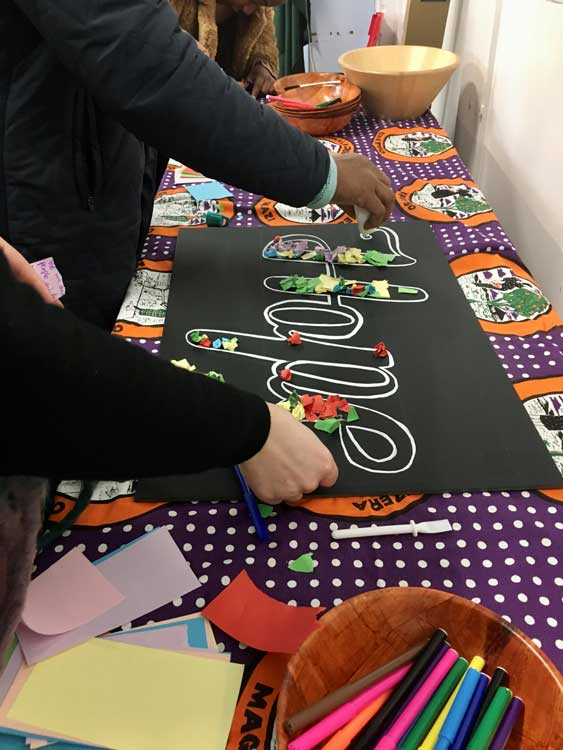
To visualise how hope emerges from even our most difficult struggles.
Scripture
Have mercy on me, my God, have mercy on me,
for in you I take refuge.
I will take refuge in the shadow of your wings
until the disaster has passed.
(Psalm 57)
The light shines in the darkness, and the darkness has not overcome it.
(John 1 v 5)
Prompt questions
- What issues are causing you to lament today?
- When was a time you felt hope, even in the middle of a difficult situation?
Activity
- Prepare a larger poster and write the template of a word that represents hope to you and your community on it. You could also write "Hope" as we have in the example. Bring small, coloured pieces of paper and pens.
- During a time of prayer or sung worship, invite people to write down their lament or prayer on a coloured piece of paper, offering them to God. You can invite children to draw a picture of something that makes them sad or that they would like to talk to God about.
- Then ask people to tear up their piece of paper and stick it onto the poster to create a new image, as something beautiful is created out of brokenness.
Lesson
Working with New Scots can give us many reasons to lament: the tragedy of forced migration, policies that prolong suffering, and the risk of isolation and loneliness, both for New Scots and the people who help. Being able to express our lament practically can be a helpful exercise. However, we don't want to leave people in a place of lament, but move to a place of hopefulness. We believe in a God who can redeem even the darkest of situations and bring new life.
Prayer
Loving God we bring to you all our lament and troubles, trusting that you are a God of compassion. We pray that you transform our lament into hope and breathe new life into us. Give us the courage to keep on caring and supporting others. Amen
Journeys retold: Stories of refuge and seeking asylum
Stories are important; they help us see each other's humanity, they teach us, they help us relate, they inspire, they challenge, they encourage. Sharing stories is a wonderful way to help people in our congregations understand more about the lives of those seeking sanctuary, as well as to inform our prayers and worship. You have already seen a few stories in the Journeys of Faith and Welcome videos, and here we share three more in writing which you may wish to use in your services or Bible studies.
"A Heart for Refugees"
A Heart for Refugees is a series of paintings based on photographs from the United Nations refugee agency (UNHCR) to form part of an exhibition in 2016 to share the stories and experiences of refugees from Syria. You may also wish to use this series in the "Journeys through lament and hope" section below. For all images and stories, please contact Felicity Burrows (fburrows@churchofscotland.org.uk). Please note that some might find these stories hard to read.
"Love"
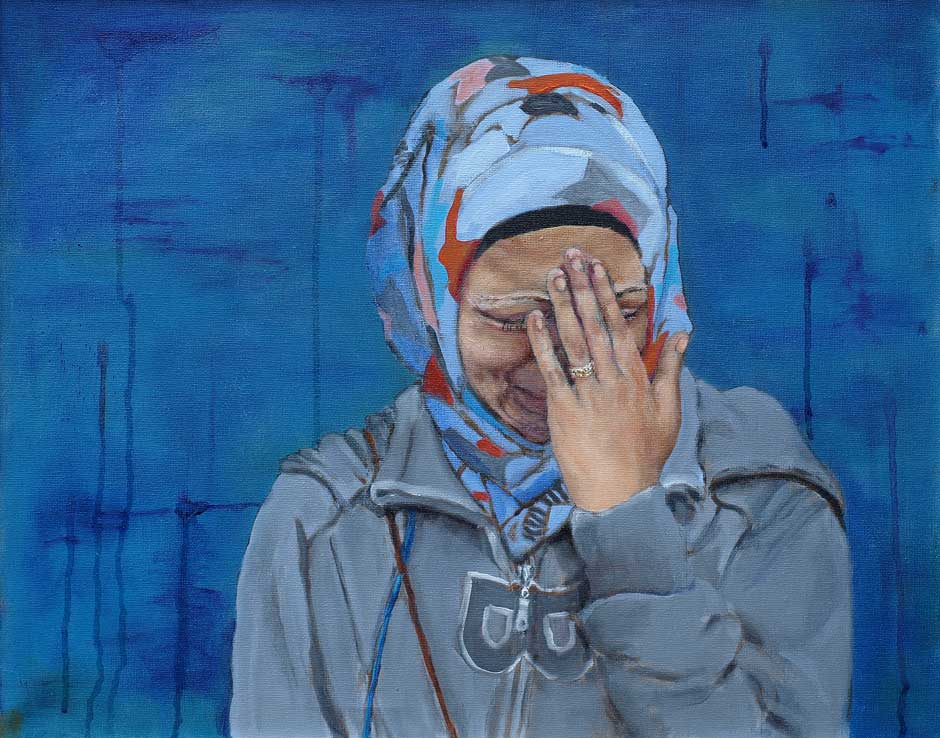
My husband and I sold everything we had to afford the journey. We worked 15 hours a day in Turkey until we had enough money to leave. The smuggler put 152 of us on a boat. Once we saw the boat, many of us wanted to go back, but he told us that anyone who turned back would not get a refund. We had no choice. Both the lower compartment and the deck were filled with people.
Waves began to come into the boat so the captain told everyone to throw their baggage into the sea. In the ocean we hit a rock, but the captain told us not to worry. Water began to come into the boat, but again he told us not to worry. We were in the lower compartment and it began to fill with water. It was too tight to move. Everyone began to scream.
We were the last ones to get out alive. My husband pulled me out of the window. In the ocean, he took off his life jacket and gave it to a woman. We swam for as long as possible. After several hours he told me that he was too tired to swim and that he was going to float on his back and rest. It was so dark we could not see. The waves were high. I could hear him calling me but he got further and further away. Eventually a boat found me. They never found my husband.
Based on original photograph by Brandon Stanton
Painting used by permission, pennyfaux.com
Source: UNHCR Tracks: Kos, Greece. "Humans of Lesvos" 2016
"Grace"
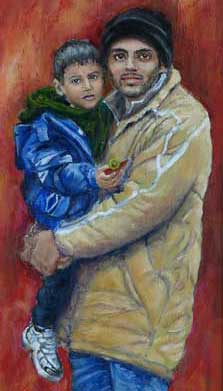
I studied to be a teacher, but I'm young, so I knew I'd be forced to fight. I don't like fighting. I don't like blood. But I was the only one working so I couldn't leave or my family would go hungry. But my mother begged me to leave. She kissed my feet. She said she wouldn't mind starving if she knew that I was safe.
I hired a smuggler but he took all my money and left me at the border. He told me that he'd call me when the passage was safe, but then he turned off his phone. I was all alone and stuck without money. I called my mother and she said that she'd pray for God to send someone to help me.
Then I met this man. I told him my story and he loaned me the money I needed to get to Europe. He treated me like one of his family. I'll pay him back, but until then I'm trying to return the favour by helping him carry his children.
Based on original photograph by Brandon Stanton
Painting used by permission, pennyfaux.com
Source: UNHCR Tracks: Vienna, Austria. "Humans of Lesvos" 2016
Story from visits to detainees at Dungavel
Rev John Carswell regularly visits the only immigration detention centre in Scotland and shares stories of his encounters. In this story, we are challenged to put ourselves in the situation of those we encounter, and unpack any preconceived ideas, privilege, judgement and stereotypes that we might have. There are more stories from John Carswell and his visits to Dungavel in the Weekly Worship resource.
Anadia*
*name changed
I don't meet many women at Dungavel IRC (Immigration Removal Centre) because it is a dedicated men's facility. Women who arrive at Dungavel will be detained for only a few days before they are moved to the women's facility in Derwentside, near Durham. I was very glad to spend time talking to Anadia and I remember her story as she was so inspirational to me and my cohort.
Anadia was from Pakistan and had come to the UK for an arranged marriage with a man she'd never met. Her two elder sisters had done the same and now had permanent right to remain. When she arrived, Anadia spoke no English. Coming from her rural village in Pakistan, she had very little education. It wasn't long into her new marriage that she discovered her husband was abusive and for a time she endured a life of domestic violence. Eventually, she decided to leave and, having made contact with one of her sisters, she left her home. This was to be a temporary arrangement because, as she explained, ‘My sister has her own husband and family and didn't really have room for me in their house.' Some time later, she moved to live with her other sister in a similar, temporary arrangement.
Anadia was determined to learn to speak English and so had enrolled in an ESOL group (English for Speakers of Other Languages). It was during one of these classes that she was arrested and held for detention. She argued vehemently with the police that her case was under review with the Home Office, and she shouldn't be detained. Unfortunately, at the time of her arrest, the police were unable to make contact with her lawyer, and so she was held.
As an asylum seeker, Anadia has very few rights in the UK. She cannot take a job or hire a flat or open a bank account or apply for a driver's licence. She is entitled to a very small stipend of £45 per week for the duration of time it takes for her asylum application to wend its way through the Home Office procedures, a process that often takes months or even years to complete. Until she is granted refugee status, she is wholly dependent on the kindness of others for her day-to-day survival. Additionally, divorce in Pakistani culture carries a heavy stigma, especially for women, so she struggles to find a place, even amongst her own countryfolk.
She is a strong, intelligent and independent young woman who now speaks fluent English and is determined to remain in the UK. Going back home, she argued, would be impossible and would deny her the opportunity for further education.
'What would you like to be?' we asked.
'I want to be an immigration lawyer.'
As someone who has been through the system, I can think of no better candidate.
Reflection
Visiting at Dungavel invariably leaves me thinking, "I don't know what I'm doing here." I feel inadequate for the task, ill-equipped and under-resourced, but then, it's not about me and my little anxieties. It is simply being present to one who is detained against their will. This is gift enough. It is a disarming feeling and one that brings me face to face with the discomfort that comes with following a crucified Saviour.
I heard it said once that, beneath the cross, there is no level ground. In other words, it's not supposed to make us feel comfortable or comforted; if we are not horrified by the cross, we are missing the point. But we go anyway, not because we want to, but because we have to, because we are called to go.
I go to Dungavel (and, in truth, to all acts of compassionate service) not because I want to, but because I need to. It is a costly grace that has been shared with me and, while Christ still suffers, naked, hungry, imprisoned, a stranger, the call remains, "Go." I can't fix their problems but strangely, they help fix mine by being kind enough and vulnerable enough to share their often-agonising stories. In doing so, our roles are reversed; it is they who welcome me.
- Rev John Carswell
Journeys through lament and hope: Creative prayer resources
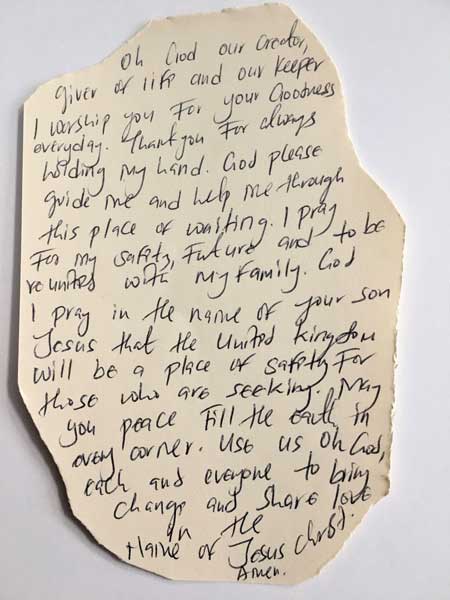
We are living in a time of great turmoil. People in Scotland and around the world are suffering deeply – from fear, violence, sickness, abuse and much more. Especially as we are confronted with the injustice of how people like those displaced from their homes are treated around us, and confronted with how we are treated and our shared experience of fatigue and fragility, we are led to feel sadness, grief, frustration, anger and sorrow. Thankfully, we do not have to bear our pain alone. God is with us and God gave us a tool that can help in times like these.
The Bible encourages us to practise a powerful kind of prayer called a lament. A lament is a way of expressing our pain to God. The Bible tells us that people found comfort in bringing their pain to God and being completely honest about how they feel. When we cry out, just like Hagar, God always listens.
In this section you will find an outline of how you might structure a time of worship that includes lament, moving to hope, and helps participants share in and lament the pain that displaced people are experiencing.
The shoreline
This time of worship focuses on the journey that refugees are making. We have taken the idea of a shoreline as a place that is a threshold, a liminal space, where one part of a journey ends and the next part begins.
First part: lament
Preparation
Create a shoreline in your gathering place, where people will be asked to bring their prayers. Consider using lengths of hessian and blue netting/voile to represent the sand and the sea, and scattered stones, sand and seashore objects on the cloths. Cut pieces of card into pebble shapes for people to write their prayers of lament and hope. These can then be placed on the shoreline.
Around the room, display pictures and their accompanying stories of refuge. Use stories recorded by refugee-supporting charities, or some of the beautiful paintings that were originally created for "A Heart for Refugees", a 2016 exhibition depicting Syrian refugees and their stories. You can find these images throughout this resource and two detailed examples in the "Journeys retold" section. For permission to use these images, please contact Felicity Burrows (fburrows@churchofscotland.org.uk).
Structure of the session
In the first part of the worship, people are invited to move around the room and spend some time considering the pictures and reading the stories, allowing their prayers of lament to rise in them. Who might be the "Hagar" in our community? If you like, you can use the call to the shoreline (call to worship) and prayer below.
During this time, your musicians might want to play or sing a Kyrie (e.g. CH4 777)a few times. The participants are then invited to write some words or prayers of lament on the pebble-shaped cards and place them on the shoreline. At this stage, you might want to sing a hymn together, letting your prayers rise to God collectively.
A call to the shoreline
We come from scattered lives, to gather at the shoreline
Where the water laps gently
Where it crashes onto rocks
In the stillness of the lakeside
In the tumult of the storm
In a gentle breeze
In a howling gale
Under a shady parasol
Under a searing sun
Where we rest and play,
Where we scramble to safety.
Where sand and water meet;
A place of arrival
A place of departure
A place of comfort
A place of desolation
We join our voices with Hagar, who honestly wept,
with Mary, who boldly said, "Yes."
We come into the presence of the God who sees us
We join with the silent strength of Stephen,
with the raw honesty of the Psalmist, who asked, "How long, Oh Lord?"
We come into the presence of the God who hears us
We join with the lament of the Israelites in exile, hoping for the Promised Land,
with the anxious and unsettled Disciples, bereft and searching for meaning.
We gather in the presence of the God who has called us here today
God who sees us,
In our coming and going
In our placing and displacing
We bring to you our lament
Lord have mercy
When others will not
Second part: from lament to hope
In the second part of the session you want to encourage people to move from a place of lament to a place of hope. There are various ways you might like to shape this in your own context:
- You could read the story of Hagar from Genesis 16 and 21, or the reflection written by Tatiana, and give people time to reflect on how God encounters her, sees her in her pain and meets her need. Genesis tells us that God was with Ishmael as he grew up. Ask people to imagine the life that Hagar and Ishmael lived. What story did they wrote for themselves?
- You could set up a couple of stations where stories of welcome and friendship are shared, or indeed take some time to watch a couple of the "Journeys of Faith and Welcome" videos. Ask people to reflect on the positive difference welcoming communities can make.
- You could invite people to move around the room again, looking at the same images, but this time imagining the hope attached to each of the stories. What would a different future look like for them? How could our churches make a difference for them?
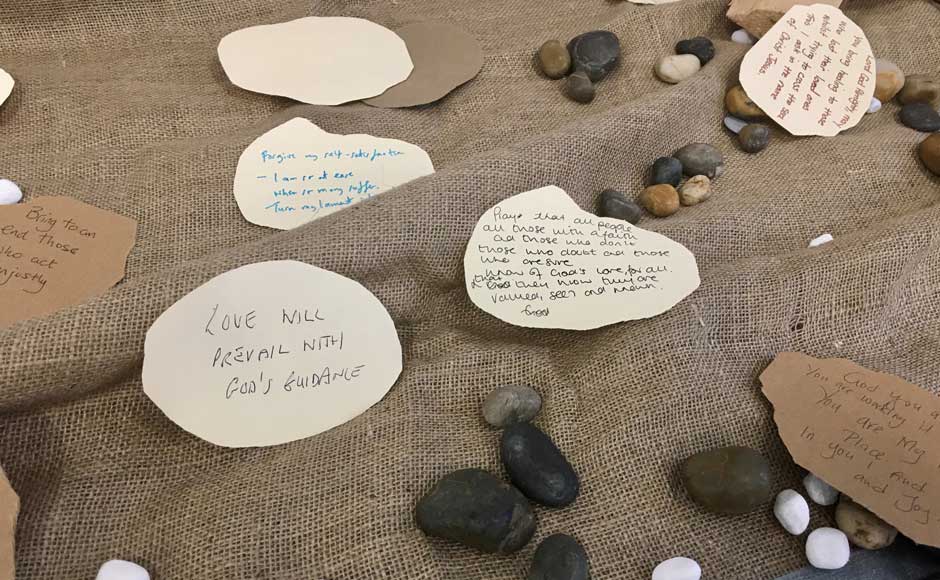
When they are ready, invite people to write words or prayers of hope on the pebble cards and add them to the prayers of lament on the shoreline.
Some will place their prayers in the sand – perhaps this is a hope that will act as a foundation when everything else seems unstable or shifting. Or perhaps they are aware that this hope may be covered up and lost. Others will place them in the water, in the knowledge that it may sink and be lost if not attended to. Or perhaps they may hope that in placing it in the water there will be a ripple effect.
Conclude your worship with a hymn or public prayer.
A prayer to lead us into hope
God who sees
In our coming and going
In our placing and displacing
We bring to you our hope and dreams for a better future
Lord have mercy
When others will not
Pause to ponder
If there are people in your congregation who have lived experience of seeking sanctuary why not encourage them to lead or write some prayers for your Sunday service? It is incredibly enriching to use the words of those displaced in our times of prayer. A richness of prayer resources can be found in our God With Us worship resource on the topic of refuge.